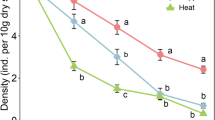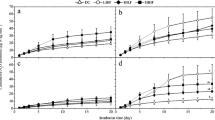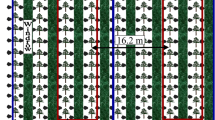Abstract
Herbs and grasses may episodically be exposed to elevated concentrations of potentially toxic elements as H+ and Al3+ due to considerable temporal variability in the chemical composition of soil solutions in the uppermost layer of the soil profile. Greenhouse experiments were performed to test the effect of episodes of different length (1 and 2 weeks) and concentrations of H+ and Al3+ (pH 3.8, 4.0, 4.2 and 4.5; 0, 20 and 70 μM Al) on root and shoot growth, designed to elucidiate the reversibility of growth inhibition. Three forest floor species were studied-Galium odoratum and Lamium galeobdolon, having similar pH distribution ranges in the field and Poa nemoralis which also occurs at slightly lower pH. The plants were grown for 5 weeks (episode and recovering time) in a synthetic soil solution in a flowing solution system without recirculation. The species reacted in three different ways. Galium odoratum was the most sensitive species and seemed to be irreversibly damaged (ceased growth) by 2 week episodes of pH≤4.0 and Al≥20 μM at pH≤4.2. Lamium galeobdolon was about equally sensitive during the episodes but it had a much greater ability to recover. Poa nemoralis was rather insensitive to the episode treatments tested. It is concluded that episodes of elevated H+ and Al3+ concentrations may be decisive for plant performance. It is therefore important to consider the extreme environmental conditions which plants may be exposed to in the field, in addition to long-term averages of e.g. soil solution concentration of potentially toxic elements, when studying species distribution and performance in relation to soil chemical properties.
Similar content being viewed by others
References
Andersson M 1988 Toxicity and tolerance of aluminium in vascular plants. A literature review. Water Air Soil Pollut. 39, 439–462.
Andersson M 1992 Effects of pH and aluminium on growth of Galium odoratum (L.) Scop. in flowing solution culture. Environ. Exp. Bot. 32, 497–504.
Andersson M E 1993 Aluminium toxicity as a factor limiting the distribution of Allium ursinum (L.). Ann. Bot. 72, 607–611.
Andersson M E and Brunet J 1993 Sensitivity to H-and Al ions limiting growth and distribution of the woodland grass Bromus benekenii. Plant and Soil 153, 243–254.
Aniol A 1984 Induction of aluminium tolerance in wheat seedlings by low doses of aluminium in the nutrient solution. Plant Physiol. 75, 551–555.
Baker H and Clapham A R 1939 Seasonal variations in the acidity of some woodland soils. J. Ecol. 27, 114–125.
Beyme B, Springob G and Richter J 1987 Veränderung der Ionenkonzentration der Bodenlösung bei intensiv genutzten Braunerden der Geest im niederschlagreichen Sommer 1984. Z. Pflanzenernähr. Bodenkd. 50, 406–411.
Bjørnstad O N 1991 Changes in forest soils and vegetation in Søgne, southern Norway, during a 20 year period. Hol. Ecol. 14, 234–244.
Brunet J 1993 Environmental and historical factors limiting the distribution of rare forest grasses in south Sweden. For. Ecol. Manage. 61, 263–275.
Cambraia J, Galvani F R, Estevao M M and Sant'Anna R 1983 Effects of aluminum on organic acid, sugar and amino acid composition of the root system of sorghum (Sorghum bicolor L. Moench.). J. Plant Nutr. 6, 313–322.
Campbell B D and Grime J P 1989 A comparative study of plant responsiveness to the duration of episodes of mineral nutrient enrichment. New Phytol. 112, 261–267.
Edmeades D C, Wheeler D M and Clinton O E 1985 The chemical composition and ionic strength of soil solutions from New Zealand topsoils. Aust. J. Soil Res. 23, 151–165.
Falkengren-Grerup U 1986 Soil acidification and vegetation changes in deciduous forest in southern Sweden. Oecologia 70, 339–347.
Falkengren-Grerup U 1987 Long-term changes in pH of forest soils in southern Sweden. Scand. J. For. Res. 1, 219–232.
Falkengren-Grerup U 1994 Importance of soil solution chemistry to field performance of Galium odoratum and Stellaria nemorum. J. Appl. Ecol. 31, 182–192.
Falkengren-Grerup U and Tyler G 1991 Dynamic floristic changes of Swedish beech forest in relation to soil acidity and stand management. Vegetatio 95, 149–158.
Falkengren-Grerup U and Tyler G 1992 Chemical conditions limiting survival and growth of Galium odoratum L. (Scop.) in acid forest soil. Acta Oecol. 13, 169–180.
Falkengren-Grerup U and Tyler G 1993a Experimental evidence for the relative sensitivity of deciduous forest plants to high soil acidity. For. Ecol. Manage. 60, 311–326.
Falkengren-Grerup U and Tyler G 1993b Soil chemical properties excluding field-layer species from beech forest mor. Plant and Soil 148, 185–191.
Fleming A L and Foy C D 1968 Root structure reflects differential aluminum tolerance in wheat varieties. Agron. J. 60 172–176.
Foy C D, Burns G R, Brown J C and Fleming A L 1965 Differential aluminum tolerance of two wheat varieties associated with plant-induced pH changes around their roots. Soil Sci. Soc. Am. Proc. 29, 64–67.
Foy C D, Chaney R L and White M C 1978 The physiology of metal toxicity in plants. Ann. Rev. Plant Physiol. 29, 511–566.
Foy C D, Lee E H and Wilding S B 1987 Differential aluminum tolerances of two barley cultivars related to organic acids in their roots. J. Plant Nutr. 10, 1089–1101.
Grauer U E and Horst W J 1990 Effect of pH and nitrogen source on aluminium tolerance of rye (Secale cereale L.) and yellow lupine (Lupinus luteus L.). Plant and Soil 127, 13–21.
Gupta P L and Rorison I H 1975 Seasonal differences in the availability of nutrients down a podzolic profile. J. Ecol. 63, 521–534.
Gustafsson J P, Jacks G, Stegmann B and Ross H B 1993 Soil acidity and adsorbed anions in Swedish forest soils-long-term changes. Agric. Ecosyst. Environ. 47, 103–115.
Hackett C 1965 Ecological aspects of the nutrition of Deschampsia flexuosa (L.) Trin II. The effects of Al, Ca, Fe, K, Mn, N, P and pH on the growth of seedlings and established plants. J. Ecol. 53, 315–333.
Hallbäcken L and Tamm C O 1986 Changes in soil acidity from 1927 to 1982–1984 in a forest area of south-west Sweden. Scand. J. For. Res. 1, 219–232.
Horst W J, Klotz F and Szulkiewicz P 1990 Mechanical impedance increases aluminium tolerance of soybean (Glycine max) roots. Plant and Soil 124, 227–231.
Horst W J, Wagner A and Marschner H 1982 Mucilage protects meristemes from aluminium injury. Z. Pflanzenphysiol. 105, 435–444.
Johnson D W, van Miegroet H, Lindberg S E, Todd D E and Harrison R B 1991 Nutrient cycling in red spruce forests of the Great Smoky Mountains. Can. J. For. 21, 769–787.
Joslin J D and Wolfe M-H 1989 Aluminum effects on northern red oak seedling growth in six forest soil horizons. Soil Sci. Soc. Am. J. 53, 274–281.
Joslin J D and Wolfe M-H 1992 Red spruce soil solution chemistry and root distribution across a cloud water depositon gradient. Can. J. For. Res. 22, 893–904.
Kinraide T B 1993 Aluminum enhancement of plant growth in acid rooting media. A case of reciprocal alleviation of toxicity by two toxic cations. Physiol. Plant. 88, 619–625.
Marschner H 1991 Mechanisms of adaptation of plants to acid soils. Plant and Soil 134, 1–20.
Matzner E and Cassens-Sasse E 1984 Chemische Veränderungen der Bodenlösung als Folge saisonaler Versauerungsschübe in verschiedenen Waldökoysystemen. Ber. Forschungsz. Waldökosyst./Waldsterb. 2, 50–60.
Nosko P and Kershaw K A 1992 The influence of pH on the toxicity of a low concentration of aluminum to white spruce seedlings. Can. J. Bot. 70, 1488–1492.
Robarge W P and Johnson D W 1992 The effects of acidic deposition on forested soils. Adv. Agron. 47, 1–83.
Skyllberg U 1991 Seasonal variation of pH H2O and pH CaCl2 in centimeter layers of mor humus in a Picea abies (L.) Karst. stand. Scand. J. For. Res. 6, 3–18.
Tyler G 1981 Leaching of metals from the A-horizon of a spruce forest soil. Water Air Soil Pollut. 15, 353–369.
Tyler G 1993 Soil solution chemistry controlling the field distribution of Melica ciliata L. Ann. Bot. 71, 295–301.
Zar J H 1984 Biostatistical analysis 2nd ed. Prentice-Hall International, London, UK. 718p.
Author information
Authors and Affiliations
Rights and permissions
About this article
Cite this article
Quist, M.E. Reversibility of damages to forest floor plants by episodes of elevated hydrogen- and aluminium-ion concentrations in the soil solution. Plant Soil 176, 297–305 (1995). https://doi.org/10.1007/BF00011794
Received:
Accepted:
Issue Date:
DOI: https://doi.org/10.1007/BF00011794




